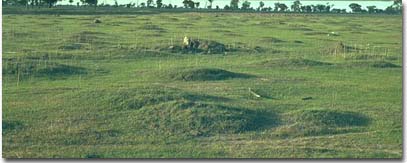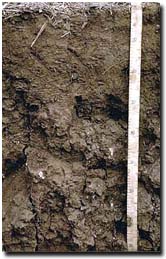Victorian State Soil Contender - Grey Vertosol

Back to: Contenders for State Soil
Why should the Grey Vertosol be Victoria’s State Soil?
- This soil will crack you up – literally! The Grey Vertosol is a cracking clay soil that has some really interesting features and lots of great vocabulary to describe it (like slickensides and lenticular peds!)
- It is one of Victoria’s most fertile soils and forms with a the self-mulching surface are prized for dryland cropping in the Wimmera region. In the northern riverine plains of Victoria, where irrigation is available, these soils are used extensively for cropping (particularly tomatoes) as well as for dairy grazing.
- Vertosols can be found throughout much of Victoria, and occur most extensively in the Wimmera region, the northern riverine plains, and to the west of Melbourne in the western volcanic plains.
- The Queenslanders have pipped us to the post and selected the Vertosol as their State Soil. This is fair enough as Queensland has extensive areas of Vertosols that are very productive for that state.
- These soils are clayey throughout - with at least 35% clay in the surface horizon. If you walk on them when they are wet you will certainly get 'clay feet'.
- Vertosols have high shrink-swell properties that give rise to some interesting features such as 'slickensides' and other vertic features such as 'lenticular' structure. The shrinking and swelling that occurs during wetting and drying cycles is often so extreme that it causes the ground surface to rise. The land surface is characterised by an uneven series of mounds and hollows, referred to as 'gilgai'. Gilgai is a native Australian (Koori) term that is used internationally to describe this feature. The shrinking and swelling in these profiles can be responsible for disruption to fences and telephone poles as well as walls and foundations of buildings. Continuous cultivation of paddocks has resulted in the smoothing out of many of these formations. The forces that created them, however, are still operating as is evident by the displacement of fence posts, and if the land is left undisturbed for a number of wetting and drying seasons they will re-form. In areas with gilgai microrelief, crop and pasture growth is likely to be uneven across a paddock due to soil variations and poor drainage conditions in depressions.
- Because of their shrink-swell properties, Vertosols often have deep, wide cracks that open up when the soil is dry. These cracks often extend from the surface soil into the deeper subsoil.
- The surface condition of Vertosols can vary greatly and is an important determinant of its cropping potential. Surface soil can range from being hard and massive (structureless) to coarsely structured and to having many fine aggregates at the surface - known as 'self-mulching'. These fine aggregates provide a favourable 'bed' for plant germination and establishment and can also fall down cracks and end up deep in the soil profile, this behaviour often being referred to as 'self-swallowing'

Gilgai microrelief in a paddock near Horsham
Typical soil profile
|  Grey Vertosol near Horsham. | ||||||||||||||||||
Other examples of Grey Vertosols on the VRO website
Grey Vertosol near Birchip in the Mallee region
Self-mulching Grey Vertosol near Horsham in the Wimmera region


